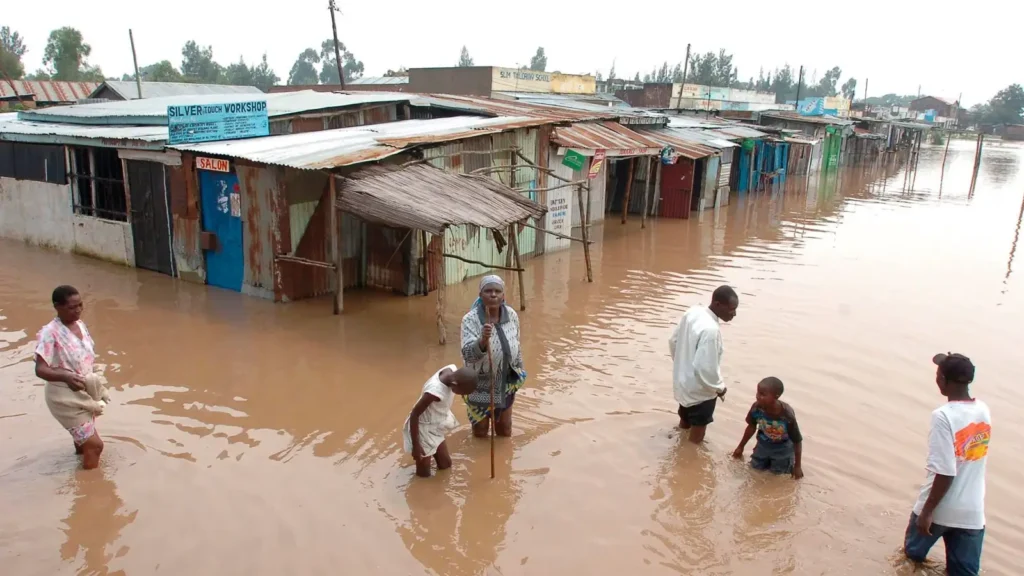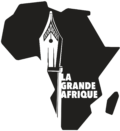
Villagers go about their business in a flooded market center in Kisumu, about 400 kilometers west of the capital Nairobi in Kenya. © EPA/Jacob Wire
Day Zero has arrived. Well, almost.
On April 12, 2018, Cape Town came close to experiencing the dreaded “Day Zero”, the day when water would no longer flow through the taps of most private households. A decision envisaged by municipal authorities following three years of devastating drought. In extremis, they managed to secure the water supply by this date, thus preventing Cape Town from becoming “the first major modern city in the world to run out of water completely”. Far from being an isolated case, this episode is merely an introduction to Africa’s existential water dilemma. A dilemma that challenges the entire continent in various ways, from water scarcity to flooding and pollution of the blue gold. This article, the first of a series of two dedicated to Africa’s pressing water conundrum, explores these three facets of the problem, each exemplified through a particular region.
Droughts: the mirage of blue gold in North Africa.
As African-American slave and mathematical genius Thomas Fuller, said in 1732, “we never know the worth of water till the well is dry”. The recent exceptional rainfall in the northern Sahara should not blind us to the fact that this constitutes a very rare episode in one of the driest regions in the world. Take the case of Morocco, a water-stressed kingdom which last year suffered “a 67% drop in rainfall […] compared with a year considered normal”, heavily affecting at the agricultural sector, main contributor to GDP and source of employment for “a third of the working-age population”. More widely in the Maghreb, the statistics are alarming, and seen as the result of a “particularly accelerated climate change in the Mediterranean basin”. The filling rates of dams in Algeria are not reassuring either, as in the case of the Koudiat Asserdoun dam, which registred a frightening filling rate of 3% at the beginning of 2023. In the same year, Tunis had to “import its entire cereal needs” after four years of drought wiped out the country’s agricultural harvests. Water scarcity is a scourge that now threatens food security in the Maghreb and elsewhere. Drought cycles are the source of numerous conflicts between farmers and livestock breeders in sub-Saharan Africa.
Pollution: West Africa wades into troubled waters.
Water pollution is another major issue, and West Africa is an evocative example. Ghana, the continent’s leading gold producer, has an enviable abundance of water, notably in his Lake Volta, the world’s largest artificial lake. Yet Accra faces a national scourge that is poisoning its blue gold. It is known as Galamsey, a word used by Ghanaians to refer to illegal mining. To realize the extent of the damage, the Ghana Water Company has announced that “60% of watercourses and reserves are so polluted that they can no longer be treated”, and Galamsey is being held responsible. Yet this seemingly obvious problem has proven to be particularly hard to solve, partly due to its conflictual nature in terms of economic output. On one hand, this sector generates almost half (43%) of the country’s total gold production, and millions of Ghanaians depend on it as a source of income. But on the other hand, the rest of society is up in arms over the resulting water pollution, and many fishermen have seen their fish stocks collapse as “the tide of illegal mining” continues to take on “terrifying proportions”, with “unprecedented” environmental damage. In response, in this country very attached to religion, a “prayer march for the environment” was led by the Archdiocese of Accra on October 11, 2024, mobilizing thousands of citizens and several civic organizations. The event comes a week after a coalition of associations called for three days of demonstrations against the same bugbear. These popular demonstrations are taking place at the height of the electoral period, giving presidential candidates the opportunity to promise an end to a scourge that has continued to plague successive governments.
The case of Ghana is emblematic, but not isolated in the region, as evidenced by the striking case of Nigeria. The continent’s leading economic and demographic power has colossal oil reserves, making it the main contributor to its GDP. However, as in Ghana, the famous resource curse is having its effect since ecosystems are devastated by oil discharges. The facts are stark: “After being the hope of an entire people in the 50s, half a century later, oil has become their worst nightmare, giving rise to corruption, kidnappings and civil war. In the Niger Delta, oil has awakened the fiercest appetites and created the biggest oil spill of all time”.
Floods: the last straw in East Africa
From Sudan to Burundi, through Kenya, DRC and Somalia, an entire region is now living to the rhythm of floods. In 2018, rising waters affected 1.5 million East Africans. The following year, this figure rose to 4 million, before climbing to 6 million by 2020. During this period, Khartoum, the capital of Sudan and the meeting point of the Blue and White Niles, saw the emblematic river rise up to 17.57 meters, “its highest level since measurements began over a century ago”. 100 people perished, while entire neighborhoods were overwhelmed by raging waters.
More recently, the El Nino climatic phenomenon has been put forward to explain the impressive series of floods moving from one country to another in East Africa, some of which are illustrated below. In December 2023, torrential rains in northern Tanzania were so powerful that they caused a massive landslide, taking away at least 63 people. Earlier the same year, Somalia experienced population displacement of spectacular proportions, with 408,000 people displaced by flooding, and a further 312,000 by drought. In the last weeks, South Sudan faced “the worst floods in decades”. More than 40 of the country’s counties are under water, affecting at least 1.4 million people. The world’s youngest country’s weak economy and internal power rivalries are doing nothing to help the South Sudanese population cope with this uncontrollable rise in water levels. These examples are just a handful in the wave of episodes recorded in the region in recent years.
